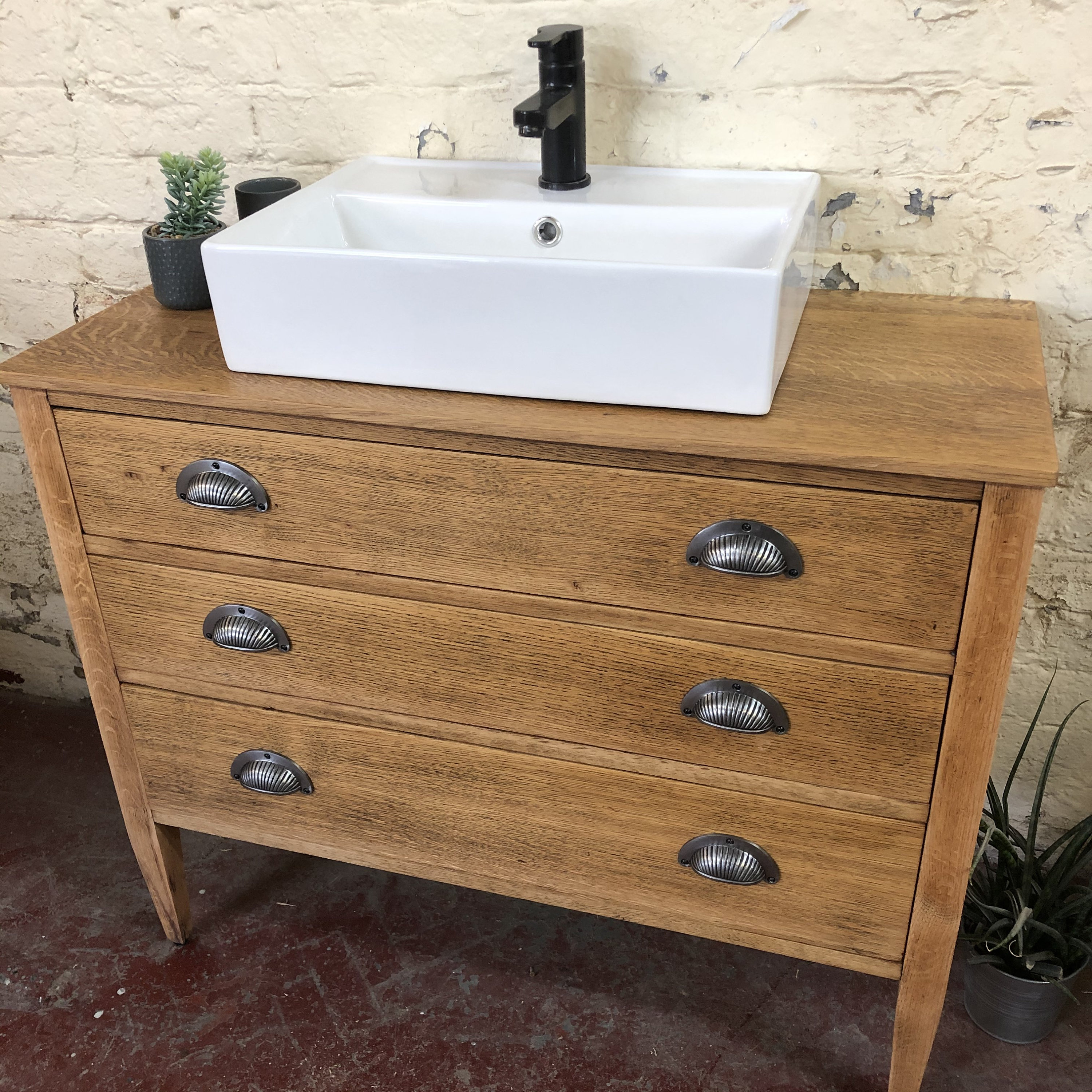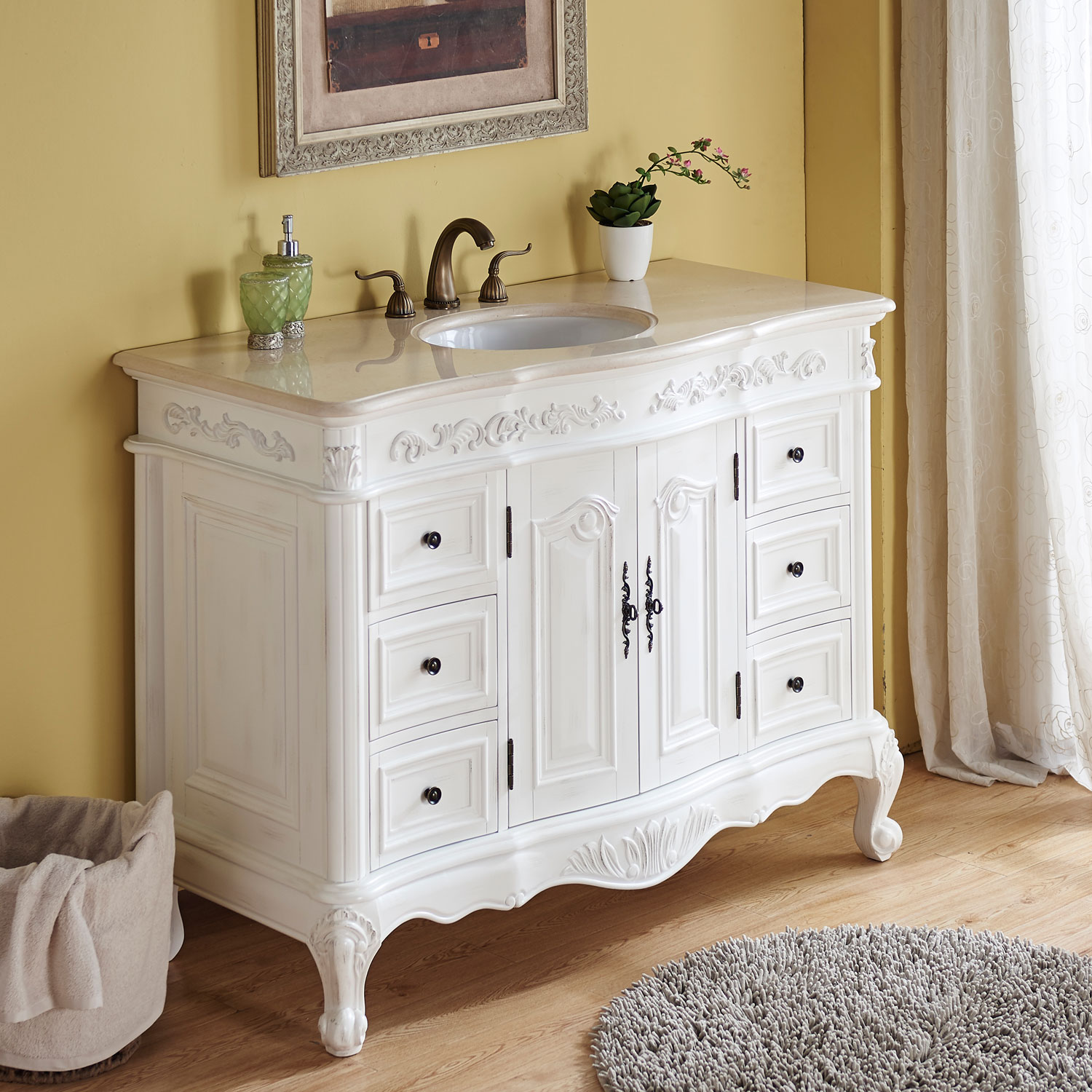The Allure of Antique Vanities: Bathroom Vanity Antique Vanity

Antique vanities, with their timeless elegance and whispers of history, possess a captivating allure that transcends mere functionality. They are not just pieces of furniture; they are portals to bygone eras, echoing the craftsmanship and aesthetics of their time.
Historical Evolution of Antique Vanities, Bathroom vanity antique vanity
Antique vanities have a rich history, their evolution mirroring the changing styles and sensibilities of different periods. The earliest vanities, dating back to the 18th century, were often simple and utilitarian, serving primarily as dressing tables. They were typically made of wood, with a mirror and a few drawers for storing toiletries.
As the 19th century progressed, vanities became more elaborate and ornate, reflecting the Victorian era’s penchant for grandeur and intricate details. This period saw the introduction of more decorative elements, such as hand-carved details, inlaid woods, and elaborate hardware.
Craftsmanship and Materials
Antique vanities are testaments to the artistry and craftsmanship of their time. They were meticulously crafted using traditional techniques and high-quality materials. The most common materials used in antique vanities include:
- Wood: Oak, mahogany, cherry, and walnut were popular choices for their durability and beauty.
- Marble: Often used for vanity tops, marble adds a touch of luxury and elegance.
- Brass: Brass hardware, including handles, knobs, and hinges, was a hallmark of antique vanities.
Famous Antique Vanities
Several antique vanities have become iconic symbols of their respective eras and are featured in historical homes, museums, and architectural landmarks. Some notable examples include:
- The vanity in the master bedroom of the White House, dating back to the early 20th century, is a prime example of a beautifully crafted antique vanity.
- The vanity in the dressing room of the Château de Fontainebleau, a French royal palace, is a stunning example of Renaissance-era craftsmanship.
- The vanity in the Metropolitan Museum of Art, a 19th-century piece, showcases the intricate details and artistry of Victorian-era design.
Aesthetic Comparison with Modern Vanities
Antique vanities stand apart from their modern counterparts in several ways. While modern vanities often prioritize functionality and minimalist aesthetics, antique vanities embrace ornate details, intricate craftsmanship, and a sense of history. The enduring appeal of antique vanities lies in their timeless elegance, unique character, and ability to transport us to a bygone era.
Finding the Perfect Antique Vanity

The hunt for an antique vanity is a thrilling adventure, a journey through time and style. It’s not just about finding a piece of furniture; it’s about discovering a story, a history, and a unique charm that resonates with your personal taste. But amidst the allure of vintage glamour, it’s crucial to navigate the world of antique vanities with knowledge and discernment.
Identifying Authentic Antique Vanities
Authenticity is the cornerstone of any antique purchase. Identifying genuine antique vanities requires a keen eye and a basic understanding of construction, materials, and stylistic elements.
- Construction and Materials: Antique vanities were often crafted with meticulous attention to detail, using solid wood like oak, mahogany, or walnut. Look for dovetail joints, mortise and tenon construction, and hand-painted finishes. Avoid vanities with flimsy construction, particleboard, or veneer that might indicate a reproduction.
- Hardware and Finishes: Original hardware, like hinges, knobs, and pulls, can provide valuable clues. Antique hardware is often made of brass, bronze, or porcelain, with intricate designs and patina that develops over time. Pay attention to the finish, noting signs of wear, chipping, or discoloration that are consistent with age.
- Style and Period: Each era has its distinct design aesthetic. Victorian vanities are known for their ornate carvings, elaborate details, and dark wood finishes. Art Deco vanities embrace geometric patterns, sleek lines, and bold colors. Mid-Century Modern vanities feature clean lines, simple forms, and a focus on functionality. Researching these styles can help you pinpoint the authenticity of a vanity.
Types of Antique Vanities
Antique vanities offer a spectrum of styles, each with its own allure and appeal. Understanding these styles can guide your search for the perfect piece.
- Victorian Vanities: Victorian vanities exude elegance and grandeur. They typically feature intricate carvings, elaborate details, and dark wood finishes like mahogany or walnut. These vanities often have a large, ornate mirror and multiple drawers for storage.
- Art Deco Vanities: Art Deco vanities embody the glamour and sophistication of the 1920s and 1930s. They are characterized by geometric patterns, sleek lines, and bold colors. Materials like chrome, nickel, and Bakelite are often incorporated, reflecting the era’s embrace of modern design.
- Mid-Century Modern Vanities: Mid-Century Modern vanities capture the spirit of the 1950s and 1960s. They feature clean lines, simple forms, and a focus on functionality. Materials like teak, rosewood, and laminates are common, reflecting the era’s love of natural materials and minimalist aesthetics.
Reputable Antique Dealers and Online Marketplaces
Finding the right antique vanity often involves connecting with reputable dealers and exploring online marketplaces.
- Antique Dealers: Local antique shops and galleries can offer a curated selection of antique vanities. Look for dealers who have a reputation for authenticity and expertise. Don’t hesitate to ask questions about the provenance of the vanity, its history, and any restoration work performed.
- Online Marketplaces: Websites like eBay, Etsy, and Chairish specialize in antique furniture, including vanities. These platforms provide access to a vast inventory from various sellers. Be sure to read seller reviews and scrutinize the descriptions and photographs to ensure authenticity and condition.
Evaluating Condition and Value
Once you’ve identified a potential antique vanity, it’s essential to evaluate its condition and determine its value. This involves a careful assessment of several factors.
- Restoration Needs: Assess the vanity’s overall condition. Are there signs of wear and tear, cracks, or damage? Consider the extent of restoration needed, including refinishing, repairs, or replacing missing parts. Factor these costs into your budget.
- Historical Significance: Research the vanity’s history and any notable features. A vanity with a documented provenance or connection to a significant person or event can significantly increase its value. Consider consulting with an antique appraiser for a professional assessment.
Incorporating Antique Vanities into Modern Bathrooms

Antique vanities, with their intricate carvings, timeless elegance, and rich history, can effortlessly transform a modern bathroom into a sanctuary of refined style. Their unique character adds a touch of vintage charm that complements contemporary design elements, creating a harmonious blend of old and new.
Designing Bathroom Layouts with Antique Vanities
Antique vanities can seamlessly integrate into a variety of bathroom styles, from traditional to contemporary. The key is to select a vanity that complements the overall aesthetic of the space.
- Traditional Bathroom: A classic white or cream-colored antique vanity with intricate carvings and a marble countertop would perfectly complement a traditional bathroom with crown molding, wainscoting, and a clawfoot tub. Imagine a freestanding antique vanity with delicate floral motifs placed in a corner, creating a focal point in a spacious bathroom with a large window overlooking a lush garden.
- Transitional Bathroom: A transitional bathroom, characterized by a blend of traditional and modern elements, offers a versatile canvas for an antique vanity. A vanity with a sleek, minimalist design and a modern countertop would blend harmoniously with contemporary fixtures and sleek lines. Consider a vanity with a dark wood finish and a simple, geometric design, placed against a backdrop of neutral-toned walls and contemporary lighting.
- Contemporary Bathroom: Even a contemporary bathroom can embrace the allure of an antique vanity. Choose a vanity with a clean-lined design and a bold, unexpected finish. A vanity with a dark, distressed wood finish would add a touch of rustic charm to a sleek, minimalist bathroom. Imagine a vintage vanity with a black lacquer finish, paired with a modern, geometric mirror and sleek chrome fixtures, creating a striking contrast against a backdrop of white subway tiles.
